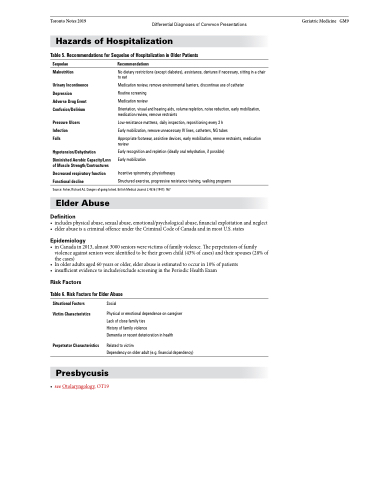Page 477 - TNFlipTest
P. 477
Toronto Notes 2019 Differential Diagnoses of Common Presentations Geriatric Medicine GM9
Hazards of Hospitalization
Table 5. Recommendations for Sequelae of Hospitalization in Older Patients
Sequelae Malnutrition
Urinary Incontinence Depression
Adverse Drug Event Confusion/Delirium
Pressure Ulcers Infection
Falls
Hypotension/Dehydration
Diminished Aerobic Capacity/Loss of Muscle Strength/Contractures
Decreased respiratory function
Functional decline
Source: Asher, Richard AJ. Dangers of going to bed. British Medical Journal 2.4536 (1947): 967
Elder Abuse
Definition
• includesphysicalabuse,sexualabuse,emotional/psychologicalabuse,financialexploitationandneglect • elderabuseisacriminaloffenceundertheCriminalCodeofCanadaandinmostU.S.states
Epidemiology
• inCanadain2013,almost3000seniorswerevictimsoffamilyviolence.Theperpetratorsoffamily violence against seniors were identified to be their grown child (43% of cases) and their spouses (28% of the cases)
• Inolderadultsaged60yearsorolder,elderabuseisestimatedtooccurin10%ofpatients
• insufficientevidencetoinclude/excludescreeninginthePeriodicHealthExam
Risk Factors
Table 6. Risk Factors for Elder Abuse
Recommendations
No dietary restrictions (except diabetes), assistance, dentures if necessary, sitting in a chair to eat
Medication review, remove environmental barriers, discontinue use of catheter
Routine screening
Medication review
Orientation, visual and hearing aids, volume repletion, noise reduction, early mobilization, medication review, remove restraints
Low-resistance mattress, daily inspection, repositioning every 2 h Early mobilization, remove unnecessary IV lines, catheters, NG tubes
Appropriate footwear, assistive devices, early mobilization, remove restraints, medication review
Early recognition and repletion (ideally oral rehydration, if possible) Early mobilization
Incentive spirometry, physiotherapy
Structured exercise, progressive resistance training, walking programs
Situational Factors Victim Characteristics
Perpetrator Characteristics
Social
Physical or emotional dependence on caregiver Lack of close family ties
History of family violence
Dementia or recent deterioration in health
Related to victim
Dependency on older adult (e.g. financial dependency)
Presbycusis
• seeOtolaryngology,OT19


